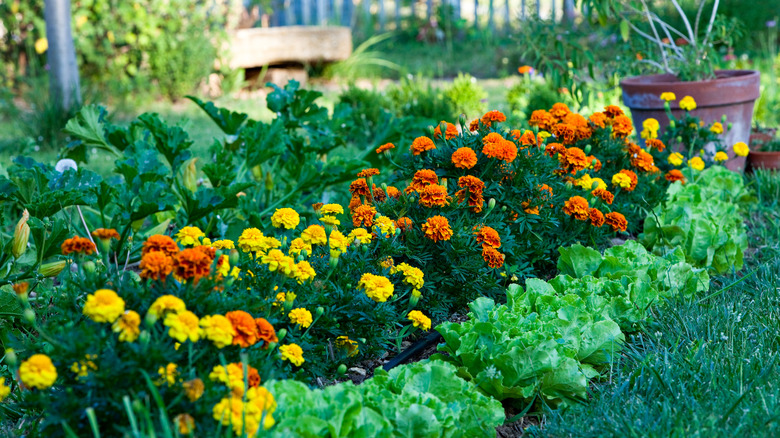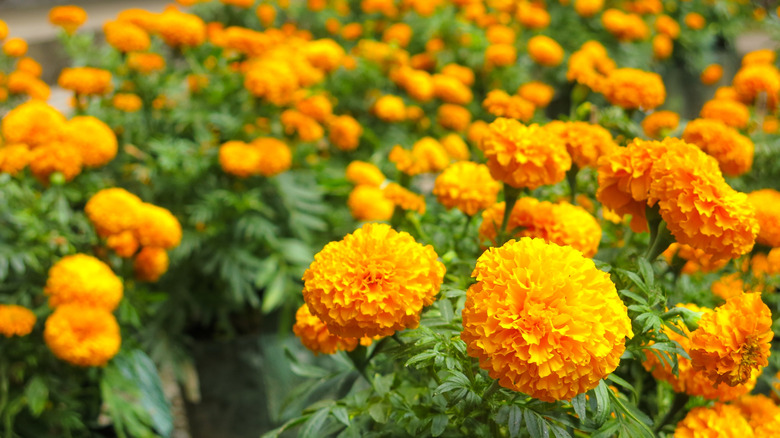The Mistake Many People Make When Planting Marigolds As Companion Plants
Marigolds have a reputation for being easy-to-grow plants that make great companions for cucumbers and other veggies in your garden. In fact, Tiffany Selvey, House Digest's Garden Editor and in-house Master Gardener, says, "When I was growing up, my grandpa planted them in nearly every row of his garden – partly to repel pests and partly because he just liked them." Still, you have to give some thought to exactly where you are planting your marigolds, because many gardeners make the mistake of planting them too close to the plants they are there to protect.
"Marigolds grow well with and may benefit tomatoes, squash, cabbage, and pretty much any other plant in the garden," Selvey shared in an exclusive interview with House Digest. The strong scent may help repel common garden pests like aphids and whiteflies, but even if they don't, Selvey says they add a pretty pop of color to the garden. However, if you plant marigolds too close to your fruits and veggies, you risk causing other issues. The trick to getting spacing right is knowing exactly what kind of marigolds you have.
Overcrowding can cause other issues
Most gardeners already know that properly mapping and spacing your vegetable garden is key to success. So, don't go throwing marigolds, or any other companion plant, into the soil without thinking it through first. "Marigolds are wonderful companion plants, but if you don't give them adequate spacing they can compete with heavy feeders, like tomatoes, for water and nutrients," says Tiffany Selvey.
You don't want your companion plants to turn into competition, but that is not the only concern. "These flowers also grow very quickly, so they could choke out smaller seedlings that grow more slowly, like peppers," Selvey says in this exclusive interview with House Digest. You can even cause fungal issues if your marigolds go wild and restrict airflow to your veggies.
It's also important to remember that marigolds reseed themselves pretty liberally. "If you want free marigolds next year, it doesn't hurt to let them go to seed because they're easy to transplant," says Selvey. However, if you don't want volunteer marigolds crowding next year's plants, keeping these plants deadheaded — removing spent blooms before they dry out — will be important. Alternatively, deadheading some while leaving others may be a way to get free plants without creating excessive work next year.
How to avoid spacing mistakes with your marigolds
When you're picking up your marigolds at the nursery, they can be deceiving. What might look like a puny plant can grow quite big, which is why Tiffany Selvey tells us it is important to know exactly which kind of marigold you are planting. She says, "French marigolds only grow to about 1 foot tall and wide, while African marigolds can reach a few feet tall!" Of course, there are other things to consider when using any marigold as a companion plant, such as what plants they are meant to be companions for.
Selvey's advice for House Digest readers in this exclusive interview is to keep in mind how big your vegetable plants will be when they mature. "Take the sizes of both those plants into consideration and space your marigolds accordingly," she says. "I always encourage people to use an online garden planner or my personal favorite, graph paper, to plan your garden before planting to ensure everything is spaced correctly." There are plenty of ways to create a flourishing garden, even in a small space. One of the major keys to any successful garden is taking the time to plan before you put a single shovel in the ground.


